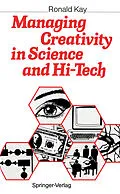The growing role of science and technology in modern society has generated a need for unique management skills on the part of scientists and engineers. While this need is widely recognized, there is little agreement on the most appropriate way in which it should be satisfied. The general literature on management does not usually recognize the problems that are unique to those engaged in science and high technology. This lack is also reflected in the considerable variety of formal management training, which more often than not has missed its mark, at least when judged by the response of participating scientists and engineers. My recent experience, teaching graduate students and prac ticing scientists and engineers about those aspects of manage ment that are likely to be most relevant to their future endea vors, has been the principle motivation for this book. The book reflects some of what I have learned from that experience and has been further encouraged by the convic tions that (1) the distribution of management potential among engi neers and scientists is no different from that of other groups with comparable academic achievement; (2) successfully managed scientific and technical enterprise provides the most useful source of learning, and (3) the process of learning is facilitated by referring to the experience that has proven effective in creating an environ ment in which scientific and technical enterprise has flour ished.
Inhalt
1. Introduction.- 2. Outline.- 3. Is the Management of Creative People Desirable?.- 3.1 Does Management Understand Creative People?.- 3.2 Creative People Do Not Need Management!.- 3.3 Characteristics of a Creative Hi-Tech Professional.- 3.4 Managing Creative People - Our Hypothesis.- 3.5 Creative Team Effort.- 3.6 Individual Creative Effort.- 3.7 Summary.- 4. Managing Your Own Work.- 4.1 Objectives, Activities and Results.- 4.2 Efficiency and Effectiveness.- 4.3 Dealing with the "Incompetent" Project Leader.- 4.4 Work-Habits of the Successful.- 4.5 Publications.- 4.6 Managing the Use of Time.- 4.7 Supporting Decisions.- 4.8 Summary.- 5. Desired Qualifications of Managers.- 5.1 Picking the "Best" Available.- 5.2 Qualifications of Project Manager.- 5.3 Qualifications of Department Manager.- 5.4 Qualifications of the Top-Level Manager.- 5.5 Leadership - To Lead or to Mislead.- 5.6 Summary.- 6. Managing a Project.- 6.1 The Expectations of the Project Members.- 6.2 Management Initiative.- 6.3 The Role of Estimates and Schedules.- 6.4 Communication Within the Project.- 6.5 Communication with Those Outside the Project.- 6.6 Formal Project-Tracking Schemes.- 6.7 Report Writing.- 6.8 Patents.- 6.9 Summary.- 7. Some Aspects of Managing a Department or Small Enterprise.- 7.1 Developing a Strategy.- 7.2 Elements of a Strategy.- 7.2.1 Environment.- 7.2.2 Mission.- 7.2.3 Potential Impact.- 7.2.4 Usefulness of Strategy.- 7.3 Developing an Operating Plan.- 7.4 The Financial Plan.- 7.5 Summary.- 8. Managing Creative People in the Hi-Tech Environment.- 8.1 Managing People I: Recruiting.- 8.1.1 Recruiting - The Applicant's Position.- 8.1.2 What Management Potential?.- 8.1.3 The On-Site Interview.- 8.1.4 The Recruiter's Position.- 8.2 Managing People II: Performance Evaluation.- 8.2.1 Why Performance Evaluation?.- 8.2.2 The Evaluation Process.- 8.2.3 Observations About the Evaluation Process.- 8.2.4 Consequences of the Evaluation - Wanted and Unwanted.- 8.2.5 Opinion Surveys.- 8.3 Managing People III: Compensation.- 8.3.1 The Hybrid "Experience-Merit" Approach.- 8.3.2 The "Merit Only" Approach.- 8.3.3 Ranking Criteria.- 8.3.4 Ranking - Public or Private?.- 8.3.5 Non-monetary Compensation.- 8.4 Managing People IV: Women in Hi-Tech.- 8.4.1 The Woman Entrepreneur.- 8.4.2 The Burden on Women.- 8.4.3 Organizational Attitudes.- 8.5 Managing People V: Management Style.- 8.5.1 Is There A WAY of Managing People?.- 8.5.2 Guidelines Versus Rules.- 8.5.3 Management Style - Perceived Positively.- 8.5.4 Management Style - Perceived Negatively.- 8.5.5 Summary - Managing People.- 9. Evaluation of Research and Development.- 9.1 Evaluation at the Project Level.- 9.2 Evaluation at the Department Level.- 9.3 Evaluation at the Top Level.- 9.4 The Importance of Under-the-Table-Projects.- 9.5 General Observations About Project Evaluation.- 9.6 The Evaluation Process.- 9.7 Evaluation of Proposals.- 9.7.1 Considerations in the Evaluation of a Proposal for a New Project.- 9.8 Evaluation of the R & D Function.- 9.8.1 How to Evaluate an R & D Function.- 9.8.2 What Are We Getting for Our Investment?.- 9.8.3 What Is the Appropriate Amount of R&D?.- 9.8.4 Setting Priorities.- 9.9 Conclusions.- 9.10 Summary.- 10. Administrative Skills.- 10.1 The Art of Making Presentations.- 10.1.1 Know Your Audience.- 10.1.2 Presentations: Structure and Technique.- 10.1.3 Visual Aids.- 10.1.4 The Art of (Not) Listening.- 10.1.5 Summary.- 10.2 The Art of Conducting Meetings.- 10.2.1 General Guidelines.- 10.2.2 Sample Meeting Agenda.- 10.2.3 Methods for Conducting Group Meetings.- 10.2.4 Selection of Method.- 10.2.5 Tips for One-on-One Meetings.- 10.2.6 Summary.- 11. Starting a New Enterprise or New Project.- 11.1 Profile of the Entrepreneur.- 11.2 The New Enterprise.- 11.3 The Business Plan.- 11.4 Financial Controls.- 11.5 Summary.- 12. Financing Creativity - The Venture Capital Industry.- 12.1 Who Are the Venture Capitalists?.- 12.2 The Venture Capital Network.- 12.3 The Risk and Reward of Venture Capital.- 12.4 Accessibility of Experienced Management.- 12.5 The Related Infrastructure.- 12.6 Evaluation of Proposals.- 12.7 The Relative Level of Venture Capital Investment.- 12.8 Summary.- 13. Organizational Culture.- 13.1 The Matter of Trust.- 13.2 Intellectual Property - Whose?.- 13.3 Expense Accounts - Judgment or Integrity?.- 13.4 Bureaucracy - A Positive Asset?.- 13.5 Social Values.- 13.6 Cultural Values.- 13.7 Respect for the Individual.- 13.8 Relevance to Creative Effort.- 13.9 Summary.- 14. What the Behavioral Sciences Have to Offer.- 14.1 Douglas McGregor - Theory X and Theory Y.- 14.2 Abraham Maslow - Hierarchy of Needs.- 14.3 Frederick Herzberg - Motivation-Hygiene Theory.- 14.4 Rensis Likert - Four Management Styles.- 14.5 Summary.- 15. Management Training Opportunities for Engineers and Scientists.- 15.1 Short Programs.- 15.2 Basis for Selection.- 15.3 Career Development Workshops.- 15.4 Full-Time Academic Training Programs.- 15.5 Summary.- 16. Recommended Further Reading.- A.1 Management Initiative.- A.2 Ranking Criteria for an R & D Function.- A.3 New Venture Staffing Plan.- References.
